Analyzing Urban Climatic Shifts in Annaba City: Decadal Trends, Seasonal Variability and Extreme Weather Events
Abstract
:1. Introduction
2. Materials and Methods
2.1. Study Area
2.2. Scientific Methodology
2.2.1. Data Collection
2.2.2. Linear Regression Model
2.2.3. Bioclimate Tools
3. Results
3.1. Time-Series Analysis
3.1.1. Air Temperature
3.1.2. Precipitation
3.1.3. Wind Speed
3.2. Statistical Analysis
3.2.1. Future Potential Climatic Variations
3.2.2. Linear Regression Model Validation
3.2.3. Bioclimate Analysis
3.3. Spatial Analysis
3.3.1. UHI Quantification over the Agglomeration of Annaba
3.3.2. Perceived Climate of Annaba City
3.4. Extreme Weather Events Analysis
3.4.1. The Rapid Increase in Summer Temperatures
3.4.2. Characterization of Heat Atmospheric Events
4. Discussion
4.1. Decadal Trends
4.2. Potential Climatic Shifts and Seasonal Variability
4.3. Extreme Weather Events
4.4. Urban and Architectural Recommendations
4.5. Study Limitations and Future Perspectives
5. Conclusions
Author Contributions
Funding
Informed Consent Statement
Data Availability Statement
Conflicts of Interest
References
- Yuan, J.; Lin, Q.; Chen, S.; Zhao, H.; Xie, X.; Cai, Z.; Zhang, J.; Cheng, T.; Hua, M.; Zhang, R. Influence of global warming and urbanization on regional climate of Megacity: A case study of Chengdu, China. Urban Clim. 2022, 44, 101227. [Google Scholar] [CrossRef]
- Reichle, D.E. Anthropogenic alterations to the global carbon cycle and climate change. In The Global Carbon Cycle and Climate Change; Elsevier: Amsterdam, The Netherlands, 2020; pp. 209–251. [Google Scholar] [CrossRef]
- Nash, N.; Whitmarsh, L.; Capstick, S.; Gouveia, V.; Araújo, R.d.C.R.; dos Santos, M.; Palakatsela, R.; Liu, Y.; Harder, M.K.; Wang, X. Local climate change cultures: Climate-relevant discursive practices in three emerging economies. Clim. Chang. 2019, 163, 63–82. [Google Scholar] [CrossRef] [PubMed]
- Mateos, R.M.; Sarro, R.; Díez-Herrero, A.; Reyes-Carmona, C.; López-Vinielles, J.; Ezquerro, P.; Martínez-Corbella, M.; Bru, G.; Luque, J.A.; Barra, A.; et al. Assessment of the Socio-Economic Impacts of Extreme Weather Events on the Coast of Southwest Europe during the Period 2009–2020. Appl. Sci. 2023, 13, 2640. [Google Scholar] [CrossRef]
- Prall, M.; Olazabal, M.; Lehmann, M. Socio-economic projections in urban climate change adaptation planning: Practices and prospects for just adaptation. Habitat Int. 2023, 142, 102946. [Google Scholar] [CrossRef]
- Nuruzzaman, M. Urban Heat Island: Causes, Effects and Mitigation Measures—A Review. Int. J. Environ. Monit. Anal. 2015, 3, 67–73. [Google Scholar] [CrossRef]
- Yang, L.; Qian, F.; Song, D.-X.; Zheng, K.-J. Research on Urban Heat-Island Effect. Procedia Eng. 2016, 169, 11–18. [Google Scholar] [CrossRef]
- Ponraj, M.; Lee, Y.Y.; Din, M.F.M.; Noor, Z.Z.; Iwao, K.; Chelliapan, S. Overview of Urban Heat Island (UHI) phenomenon towards human thermal comfort. Environ. Eng. Manag. J. 2017, 16, 2097–2111. [Google Scholar] [CrossRef]
- Oukawa, G.Y.; Krecl, P.; Targino, A.C. Fine-scale modeling of the urban heat island: A comparison of multiple linear regression and random forest approaches. Sci. Total Environ. 2022, 815, 152836. [Google Scholar] [CrossRef] [PubMed]
- de Almeida, C.R.; Teodoro, A.C.; Gonçalves, A. Study of the urban heat island (Uhi) using remote sensing data/techniques: A systematic review. Environments 2021, 8, 105. [Google Scholar] [CrossRef]
- Udara, P. Air pollution in urban areas and health effects. J. Antarabangsa Alam Tamadun Melayu 2016, 4, 25–33. [Google Scholar]
- Puigserver, D.; Giménez, J.; Gràcia, F.; Granell, À.; Carmona, J.M.; Torrandell, A.; Fornós, J.J. Effects of global and climate change on the freshwater-seawater interface movement in a Mediterranean karst aquifer of Mallorca Island. Sci. Total Environ. 2024, 912, 169246. [Google Scholar] [CrossRef] [PubMed]
- Hameed, H.M. Estimating the effect of urban growth on annual runoff volume using GIS in the Erbil Sub-Basin of the Kurdistan Region of Iraq. Hydrology 2017, 4, 12. [Google Scholar] [CrossRef]
- Tomczyk, A.M.; Mendel, K. Characteristics of Biometeorological Conditions in Poland during the Long May Weekend Based on the Universal Thermal Climate Index. Atmosphere 2023, 14, 1334. [Google Scholar] [CrossRef]
- Tesselaar, M.; Botzen, W.J.W.; Aerts, J.C. Impacts of climate change and remote natural catastrophes on eu flood insurance markets: An analysis of soft and hard reinsurance markets for flood coverage. Atmosphere 2020, 11, 146. [Google Scholar] [CrossRef]
- Salata, F.; Falasca, S.; Ciancio, V.; Curci, G.; de Wilde, P. Climate-change related evolution of future building cooling energy demand in a Mediterranean Country. Energy Build. 2023, 290, 113112. [Google Scholar] [CrossRef]
- Carrasco, J.F.; Bozkurt, D.; Cordero, R.R. A review of the observed air temperature in the Antarctic Peninsula. Did the warming trend come back after the early 21st hiatus? Polar Sci. 2021, 28, 100653. [Google Scholar] [CrossRef]
- Swingedouw, D.; Mignot, J.; Guilyardi, E.; Nguyen, S.; Ormières, L. Tentative reconstruction of the 1998–2012 hiatus in global temperature warming using the IPSL–CM5A–LR climate model. Comptes Rendus Geosci. 2017, 349, 369–379. [Google Scholar] [CrossRef]
- Li, N.; Cuo, L.; Zhang, Y.; Ding, J. The synthesis of potential factors contributing to the asynchronous warming between air and shallow ground since the 2000s on the Tibetan Plateau. Geoderma 2024, 441, 116753. [Google Scholar] [CrossRef]
- Scafetta, N. Impacts and risks of “realistic” global warming projections for the 21st century. Geosci. Front. 2024, 15, 101774. [Google Scholar] [CrossRef]
- European Commission—Copernicus. The 2023 Annual Climate Summary Global Climate Highlights 2023; European Commission: Luxembourg, 2024. [Google Scholar]
- Dilinuer, T.; Yao, J.-Q.; Chen, J.; Mao, W.-Y.; Yang, L.-M.; Yeernaer, H.; Chen, Y.-H. Regional drying and wetting trends over Central Asia based on Köppen climate classification in 1961–2015. Adv. Clim. Chang. Res. 2021, 12, 363–372. [Google Scholar] [CrossRef]
- Adeyeri, O.E.; Zhou, W.; Ndehedehe, C.E.; Wang, X.; Ishola, K.A.; Laux, P. Minimizing uncertainties in climate projections and water budget reveals the vulnerability of freshwater to climate change. One Earth 2024, 7, 72–87. [Google Scholar] [CrossRef]
- Di Bernardino, A.; Falasca, S.; Iannarelli, A.M.; Casadio, S.; Siani, A.M. Effect of heatwaves on urban sea breeze, heat island intensity, and outdoor thermo-hygrometric comfort in Rome (Italy). Urban Clim. 2023, 52, 101735. [Google Scholar] [CrossRef]
- Mentaschi, L.; Duveiller, G.; Zulian, G.; Corbane, C.; Pesaresi, M.; Maes, J.; Stocchino, A.; Feyen, L. Global long-term mapping of surface temperature shows intensified intra-city urban heat island extremes. Glob. Environ. Chang. 2021, 72, 102441. [Google Scholar] [CrossRef]
- Bolan, S.; Padhye, L.P.; Jasemizad, T.; Govarthanan, M.; Karmegam, N.; Wijesekara, H.; Amarasiri, D.; Hou, D.; Zhou, P.; Biswal, B.K.; et al. Impacts of climate change on the fate of contaminants through extreme weather events. Sci. Total Environ. 2024, 909, 168388. [Google Scholar] [CrossRef] [PubMed]
- Sebestyén, V.; Dörgȍ, G.; Ipkovich, Á.; Abonyi, J. Identifying the links among urban climate hazards, mitigation and adaptation actions and sustainability for future resilient cities. Urban Clim. 2023, 49, 101557. [Google Scholar] [CrossRef]
- Du, H.; Wang, M.; Liu, Y.; Guo, M.; Peng, C.; Li, P. Responses of autumn vegetation phenology to climate change and urbanization at northern middle and high latitudes. Int. J. Appl. Earth Obs. Geoinf. 2022, 115, 103086. [Google Scholar] [CrossRef]
- Técher, M.; Haddou, H.A.; Aguejdad, R. Urban Heat Island’s Vulnerability Assessment by Integrating Urban Planning Policies: A Case Study of Montpellier Méditerranée Metropolitan Area, France. Sustainability 2023, 15, 1820. [Google Scholar] [CrossRef]
- Mediterranean Climate—Wikipedia. Available online: https://en.wikipedia.org/wiki/Mediterranean_climate (accessed on 14 March 2024).
- Goudeau, M.-L.S.; Reichart, G.-J.; Wit, J.; de Nooijer, L.; Grauel, A.-L.; Bernasconi, S.; de Lange, G. Seasonality variations in the Central Mediterranean during climate change events in the Late Holocene. Palaeogeogr. Palaeoclim. Palaeoecol. 2015, 418, 304–318. [Google Scholar] [CrossRef]
- Kotsias, G.; Lolis, C.J.; Hatzianastassiou, N.; Lionello, P.; Bartzokas, A. An objective definition of seasons for the Mediterranean region. Int. J. Clim. 2021, 41, E1889–E1905. [Google Scholar] [CrossRef]
- Mediterranean Climate—An Overview|ScienceDirect Topics. Available online: https://www.sciencedirect.com/topics/agricultural-and-biological-sciences/mediterranean-climate (accessed on 14 March 2024).
- Colangelo, M.; Camarero, J.J.; Gazol, A.; Piovesan, G.; Borghetti, M.; Baliva, M.; Gentilesca, T.; Rita, A.; Schettino, A.; Ripullone, F. Mediterranean old-growth forests exhibit resistance to climate warming. Sci. Total Environ. 2021, 801, 149684. [Google Scholar] [CrossRef]
- Founda, D.; Katavoutas, G.; Pierros, F.; Mihalopoulos, N. The Extreme Heat Wave of Summer 2021 in Athens (Greece): Cumulative Heat and Exposure to Heat Stress. Sustainability 2022, 14, 7766. [Google Scholar] [CrossRef]
- Jumari, N.A.S.K.; Ahmed, A.N.; Huang, Y.F.; Ng, J.L.; Koo, C.H.; Chong, K.L.; Sherif, M.; Elshafie, A. Analysis of urban heat islands with landsat satellite images and GIS in Kuala Lumpur Metropolitan City. Heliyon 2023, 9, e18424. [Google Scholar] [CrossRef] [PubMed]
- Tseliou, A.; Melas, E.; Mela, A.; Tsiros, I. Environmental Impact of Urban Design Elements in a Mediterranean City. Environ. Sci. Proc. 2023, 26, 76. [Google Scholar] [CrossRef]
- TUDE DE TYPOLOGIE ET D’EVALUATION DES PERFORMANCES DES VILLES EN MATIERE DE DEVELOPPEMENT DURABLE. Annaba.
- Sayad, B.; Helmi, M.R.; Osra, O.A.; Abed, A.M.; Alhubashi, H.H. Microscale Investigation of Urban Heat Island (UHI) in Annaba City: Unveiling Factors and Mitigation Strategies. Sustainability 2024, 16, 747. [Google Scholar] [CrossRef]
- Boussaidi, K.; Djaghrouri, D.; Benabbas, M.; Altan, H. Assessment of Outdoor Thermal Comfort in Urban Public Space, during the Hottest Period in Annaba City, Algeria. Sustainability 2023, 15, 11763. [Google Scholar] [CrossRef]
- Standards and Requirements for Climate Observations|World Meteorological Organization. Available online: https://community.wmo.int/en/standards-and-requirements-climate-observations (accessed on 14 March 2024).
- Checa, M.F.; Rodriguez, J.; Willmott, K.R.; Liger, B. Microclimate variability significantly affects the composition, abundance and phenology of butterfly communities in a highly threatened neotropical dry forest. Fla. Èntomol. 2014, 97, 1–13. [Google Scholar] [CrossRef]
- Papadopoulos, G.; Keppas, S.C.; Parliari, D.; Kontos, S.; Papadogiannaki, S.; Melas, D. Future Projections of Heat Waves and Associated Mortality Risk in a Coastal Mediterranean City. Sustainability 2024, 16, 1072. [Google Scholar] [CrossRef]
- Yang, X.; Zhao, L.; Bruse, M.; Meng, Q. Evaluation of a microclimate model for predicting the thermal behavior of different ground surfaces. J. Affect. Disord. 2013, 60, 93–104. [Google Scholar] [CrossRef]
- Pellicone, G.; Caloiero, T.; Guagliardi, I. The De Martonne aridity index in Calabria (Southern Italy). J. Maps 2019, 15, 788–796. [Google Scholar] [CrossRef]
- Olgyay, V. Design with Climate: Bioclimatic Approach to Architectural Regionalism: New and Expanded Edition; Princeton University Press: Princeton, NJ, USA, 1963. [Google Scholar]
- Givoni, B. Man, Climate and Architecture, 2nd ed.; Elsevier: Amsterdam, The Netherlands, 1982. [Google Scholar]
- Wang, M.; Chen, Z.; Zhang, D.; Liu, M.; Yuan, H.; Chen, B.; Rao, Q.; Zhou, S.; Wang, Y.; Li, J.; et al. Changes in Concurrent Meteorological Extremes of Rainfall and Heat under Divergent Climatic Trajectories in the Guangdong–Hong Kong–Macao Greater Bay Area. Sustainability 2024, 16, 2153. [Google Scholar] [CrossRef]
- Moreno, M.; Bertolín, C.; Arlanzón, D.; Ortiz, P.; Ortiz, R. Climate change, large fires, and cultural landscapes in the mediterranean basin: An analysis in southern Spain. Heliyon 2023, 9, e16941. [Google Scholar] [CrossRef] [PubMed]
- Yao, R.; Wang, L.; Huang, X.; Zhang, W.; Li, J.; Niu, Z. Interannual variations in surface urban heat island intensity and associated drivers in China. J. Environ. Manag. 2018, 222, 86–94. [Google Scholar] [CrossRef]
- Zagaria, C.; Schulp, C.J.; Malek, Ž.; Verburg, P.H. Potential for land and water management adaptations in Mediterranean croplands under climate change. Agric. Syst. 2023, 205, 103586. [Google Scholar] [CrossRef]
- Filipe, A.F.; Lawrence, J.E.; Bonada, N. Vulnerability of stream biota to climate change in mediterranean climate regions: A synthesis of ecological responses and conservation challenges. Hydrobiologia 2013, 719, 331–351. [Google Scholar] [CrossRef]
- Khanh, D.N.; Varquez, A.C.; Kanda, M. Impact of urbanization on exposure to extreme warming in megacities. Heliyon 2023, 9, e15511. [Google Scholar] [CrossRef]
- Kang, S.-W.; Lee, M.-S.; Jung, J.-C. Analysis of sustainable urban forms for climate change adaptation and mitigation. Environ. Sustain. Indic. 2024, 22, 100337. [Google Scholar] [CrossRef]
- Pumo, D.; Alongi, F.; Cannarozzo, M.; Noto, L.V. Climate adaptive urban measures in Mediterranean areas: Thermal effectiveness of an advanced multilayer green roof installed in Palermo (Italy). J. Affect. Disord. 2023, 243, 110731. [Google Scholar] [CrossRef]
- Pietrapertosa, F.; Olazabal, M.; Simoes, S.G.; Salvia, M.; Fokaides, P.A.; Ioannou, B.I.; Viguié, V.; Spyridaki, N.-A.; Hurtado, S.D.G.; Geneletti, D.; et al. Adaptation to climate change in cities of Mediterranean Europe. Cities 2023, 140, 104452. [Google Scholar] [CrossRef]
- Chen, W.; Yi, L.; Wang, J.; Zhang, J.; Jiang, Y. Evaluation of the livability of arid urban environments under global warming: A multi-parameter approach. Sustain. Cities Soc. 2023, 99, 104931. [Google Scholar] [CrossRef]
- Najah, F.T.; Abdullah, S.F.K.; Abdulkareem, T.A. Urban Land Use Changes: Effect of Green Urban Spaces Transformation on Urban Heat Islands in Baghdad. Alex. Eng. J. 2023, 66, 555–571. [Google Scholar] [CrossRef]
- Malikah, S.; Avila, S.; Garcia, G.; Lakhankar, T. Historical Climate Trends and Extreme Weather Events in the Tri-State Area: A Detailed Analysis of Urban and Suburban Differences. Climate 2024, 12, 32. [Google Scholar] [CrossRef]
- Marí-Dell’olmo, M.; Oliveras, L.; Barón-Miras, L.E.; Borrell, C.; Montalvo, T.; Ariza, C.; Ventayol, I.; Mercuriali, L.; Sheehan, M.; Gómez-Gutiérrez, A.; et al. Climate Change and Health in Urban Areas with a Mediterranean Climate: A Conceptual Framework with a Social and Climate Justice Approach. Int. J. Environ. Res. Public Health 2022, 19, 12764. [Google Scholar] [CrossRef] [PubMed]
- Aksoy, K. Predicting the Potential Distribution Area of the Platanus orientalis L. in Turkey Today and in the Future. Sustainability 2022, 14, 11706. [Google Scholar] [CrossRef]
- Talhi, A.; Barlet, A.; Bruneau, D.; Aichour, B. Towards a prediction of outdoor human thermal comfort adapted for designers of urban spaces: Examining UTCI and APCI in the context of Algiers (Algeria). Int. J. Biometeorol. 2020, 64, 651–662. [Google Scholar] [CrossRef] [PubMed]
- Wemegah, C.S.; Yamba, E.I.; Aryee, J.N.; Sam, F.; Amekudzi, L.K. Assessment of urban heat island warming in the greater accra region. Sci. Afr. 2020, 8, e00426. [Google Scholar] [CrossRef]
- Shen, P.; Zhao, S. Intensifying urban imprint on land surface warming: Insights from local to global scale. iScience 2024, 27, 109110. [Google Scholar] [CrossRef] [PubMed]
- Soltani, A.; Sharifi, E. Understanding and analysing the urban heat island (UHI) effect in micro-scale. Int. J. Soc. Ecol. Sustain. Dev. 2019, 10, 14–28. [Google Scholar] [CrossRef]
- Sayad, B.; Menni, Y.; Imam, A.A.; Fallatah, A.; Faisal, K.S.; Abed, A.M.; Alhubashi, H.H.; Hegazy, I.R. Diurnal Characterization of the Atmospheric Urban Heat Island over Urban Hot Agglomerations. Int. J. Low-Carbon Technol. 2023, 18, 449–456. [Google Scholar] [CrossRef]
- Saneinejad, S.; Moonen, P.; Carmeliet, J. Comparative assessment of various heat island mitigation measures. J. Affect. Disord. 2014, 73, 162–170. [Google Scholar] [CrossRef]
- Turhan, C.; Atalay, A.S.; Akkurt, G.G. An Integrated Decision-Making Framework for Mitigating the Impact of Urban Heat Islands on Energy Consumption and Thermal Comfort of Residential Buildings. Sustainability 2023, 15, 9674. [Google Scholar] [CrossRef]
- Taleghani, M. Outdoor thermal comfort by different heat mitigation strategies—A review. Renew. Sustain. Energy Rev. 2018, 81, 2011–2018. [Google Scholar] [CrossRef]
- Yuan, C.; Ng, E.; Norford, L.K. Improving air quality in high-density cities by understanding the relationship between air pollutant dispersion and urban morphologies. Build. Environ. 2014, 71, 245–258. [Google Scholar] [CrossRef] [PubMed]
- Sayad, B.; Alkama, D.; Rebhi, R.; Menni, Y.; Ahmad, H.; Inc, M.; Sharifpur, M.; Lorenzini, G.; Azab, E.; Elnaggar, A.Y. Outdoor thermal comfort optimization through vegetation parameterization: Species and tree layout. Sustainability 2021, 13, 11791. [Google Scholar] [CrossRef]
- Aram, F.; García, E.H.; Solgi, E.; Mansournia, S. Urban green space cooling effect in cities. Heliyon 2019, 5, e01339. [Google Scholar] [CrossRef]
- Elnabawi, M.H.; Hamza, N. Behavioural Perspectives of Outdoor Thermal Comfort in Urban Areas: A Critical Review. Atmosphere 2019, 11, 51. [Google Scholar] [CrossRef]
- Abdel-Aziz, D.M.; Al Shboul, A.; Al-Kurdi, N.Y. Effects of Tree Shading on Building’s Energy Consumption—The Case of Residential Buildings in a Mediterranean Climate. Am. J. Environ. Eng. 2015, 5, 131–140. [Google Scholar] [CrossRef]
- Al-Hafiz, B.; Musy, M.; Hasan, T. A Study on the Impact of Changes in the Materials Reflection Coefficient for Achieving Sustainable Urban Design. Procedia Environ. Sci. 2017, 38, 562–570. [Google Scholar] [CrossRef]
- Copernicus: February 2024 Was Globally the Warmest on Record—Global Sea Surface Temperatures at Record High|Co-Pernicus. Available online: https://climate.copernicus.eu/copernicus-february-2024-was-globally-warmest-record-global-sea-surface-temperatures-record-high (accessed on 14 March 2024).
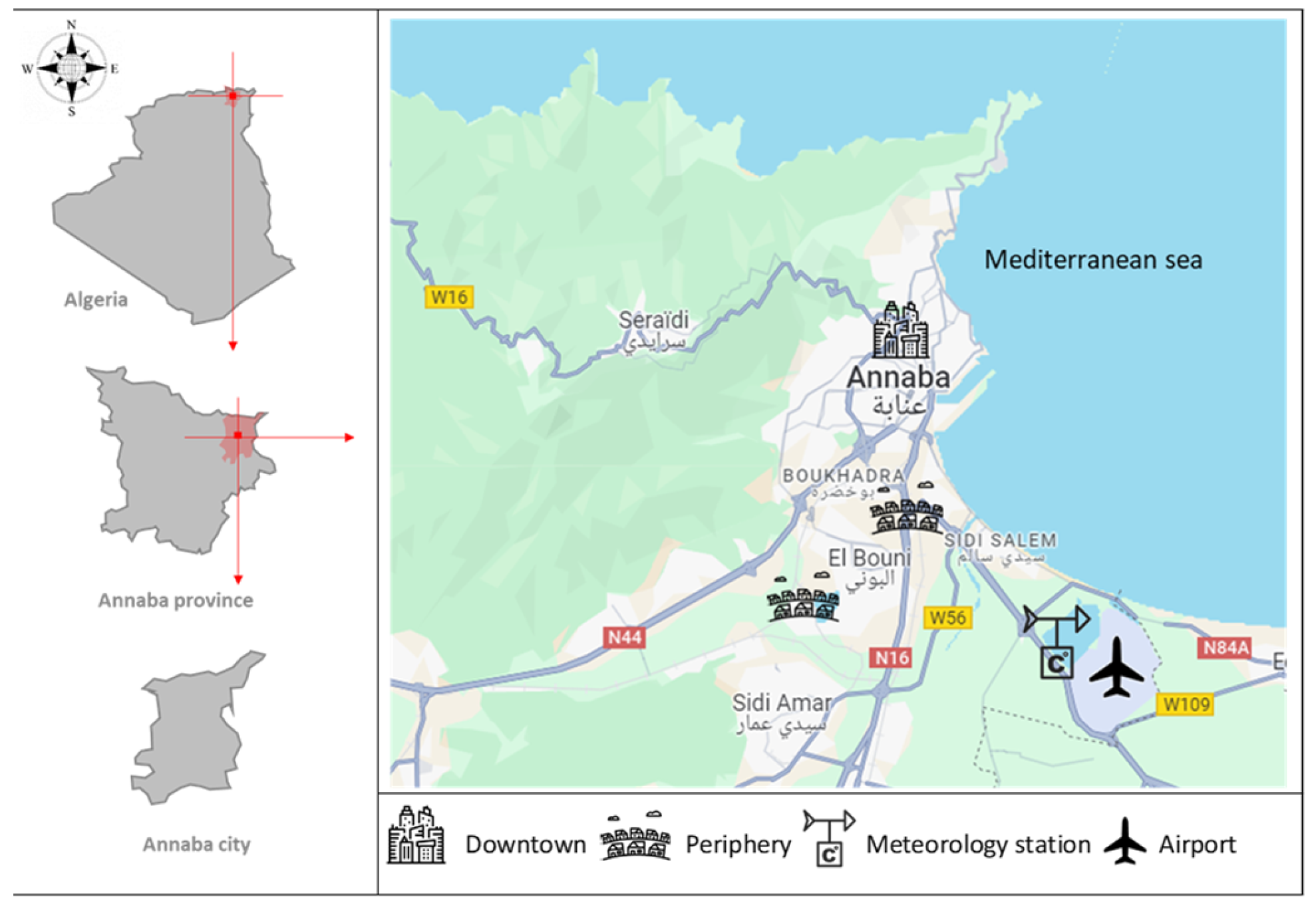
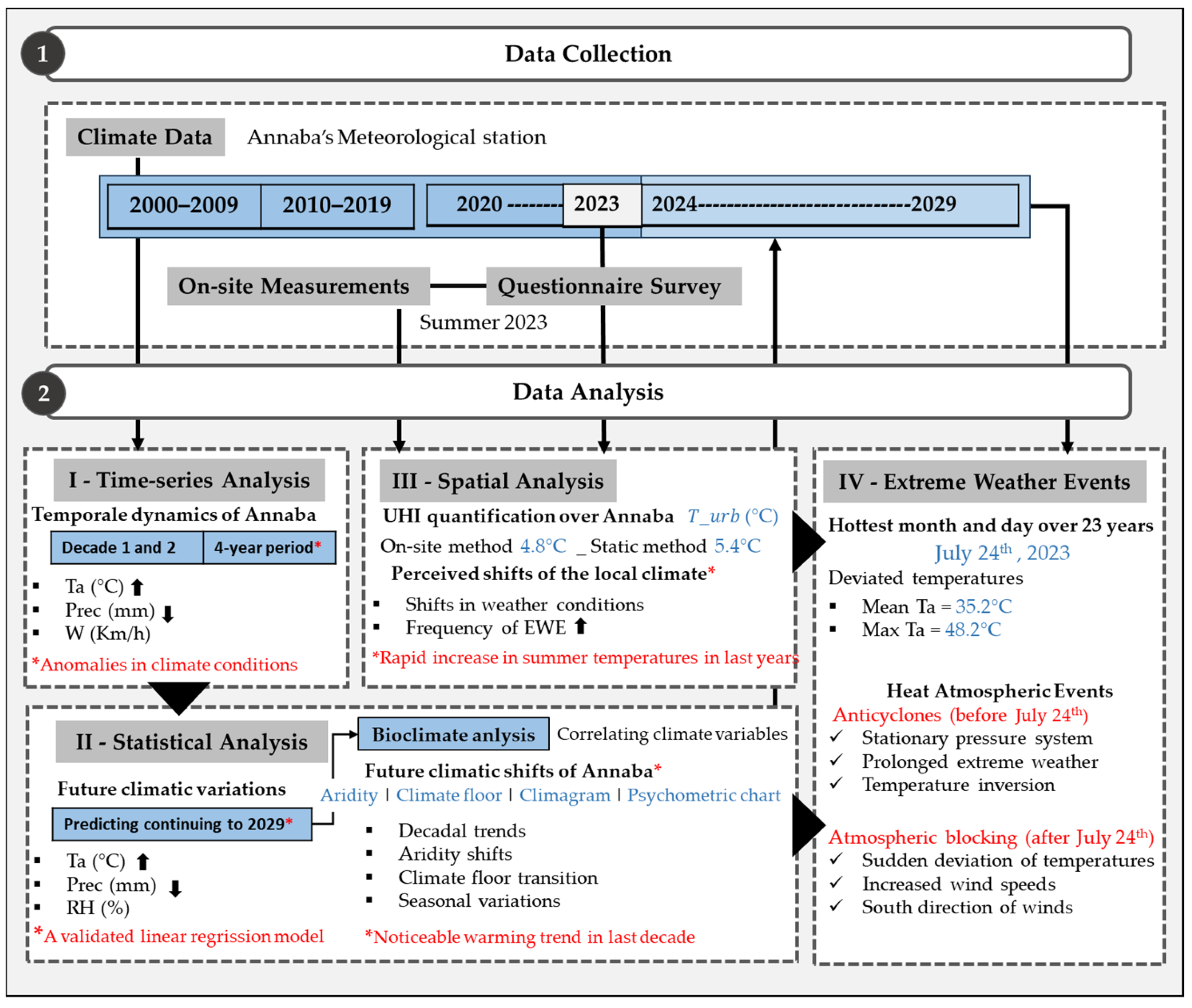

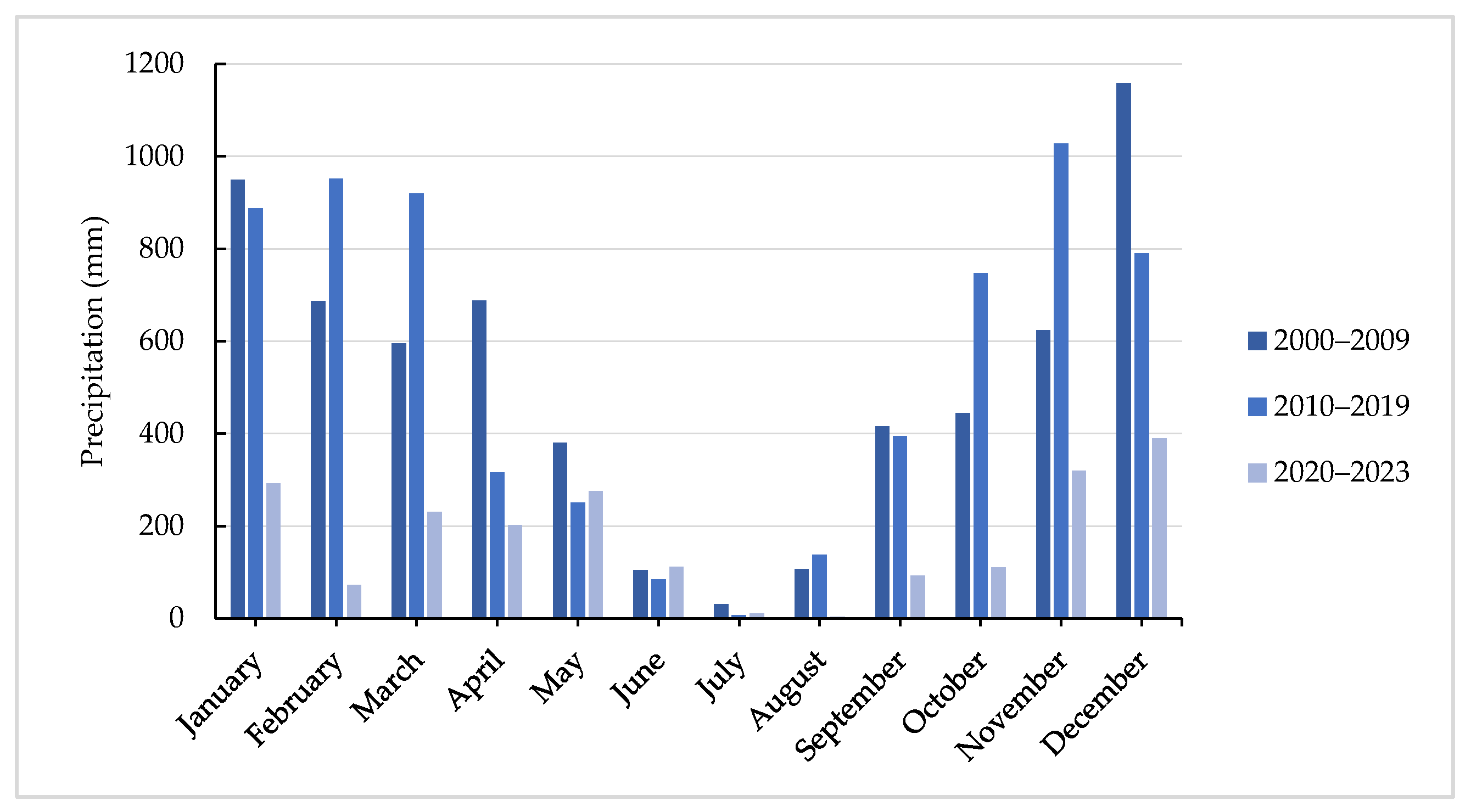
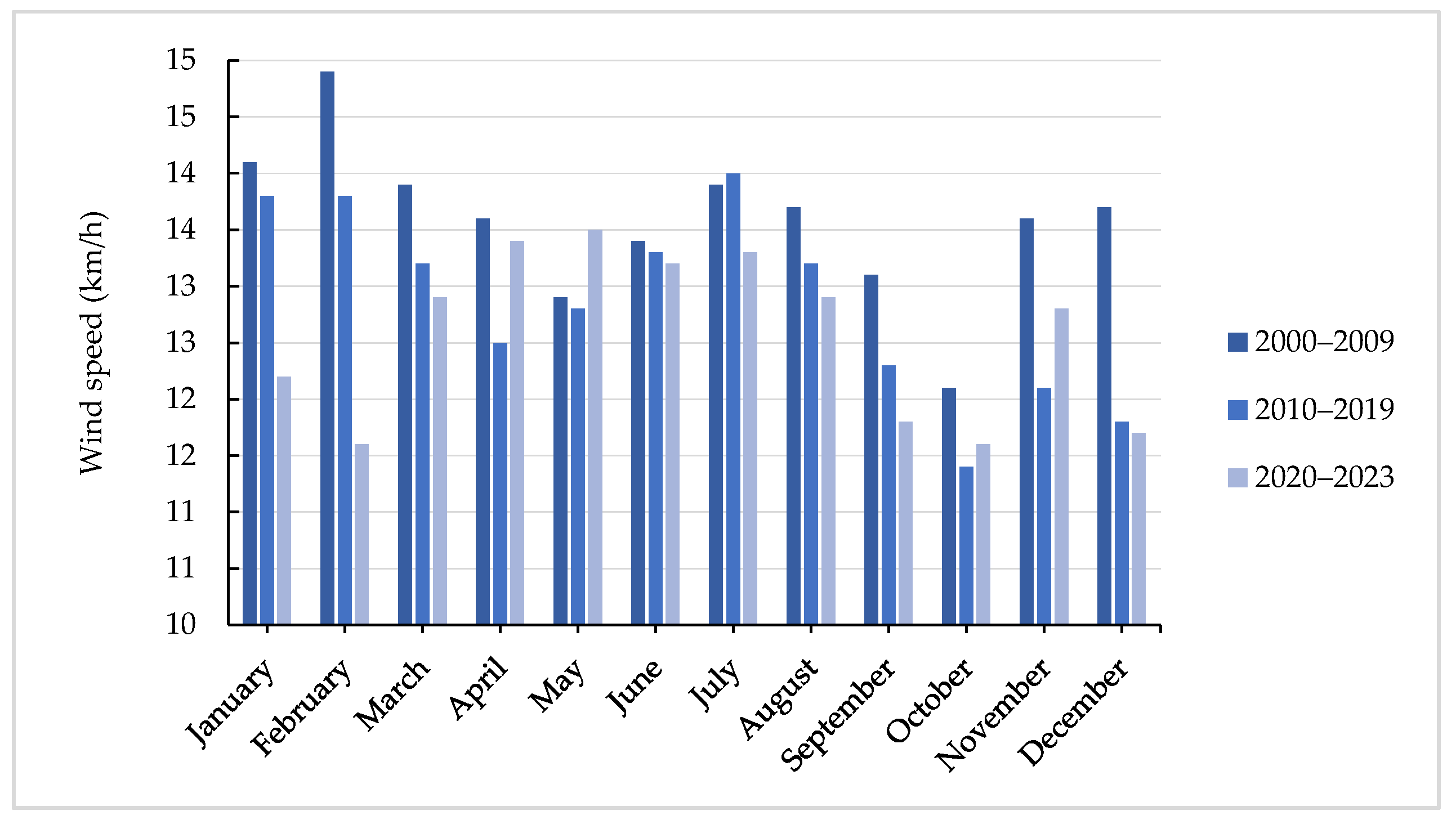

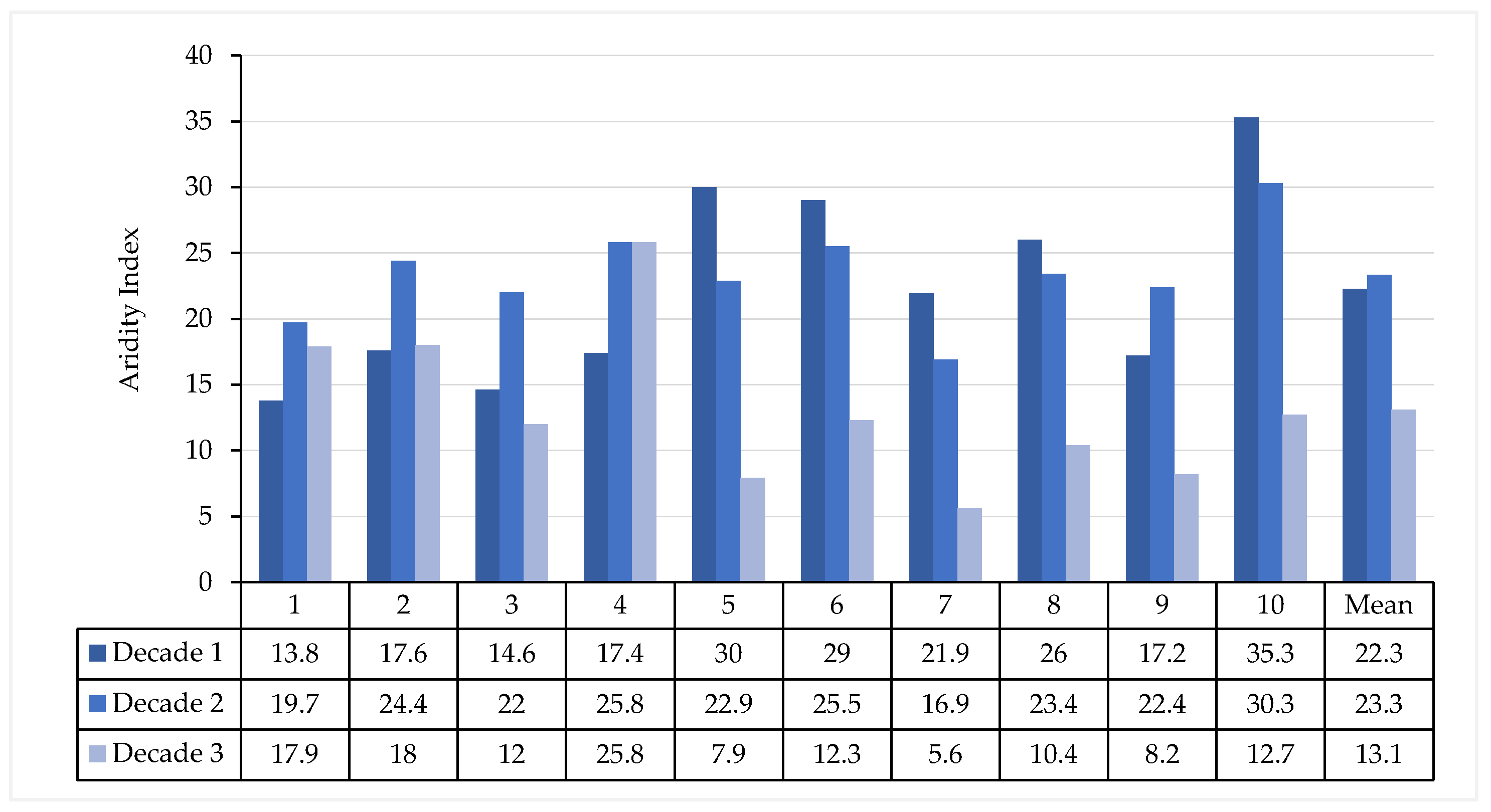
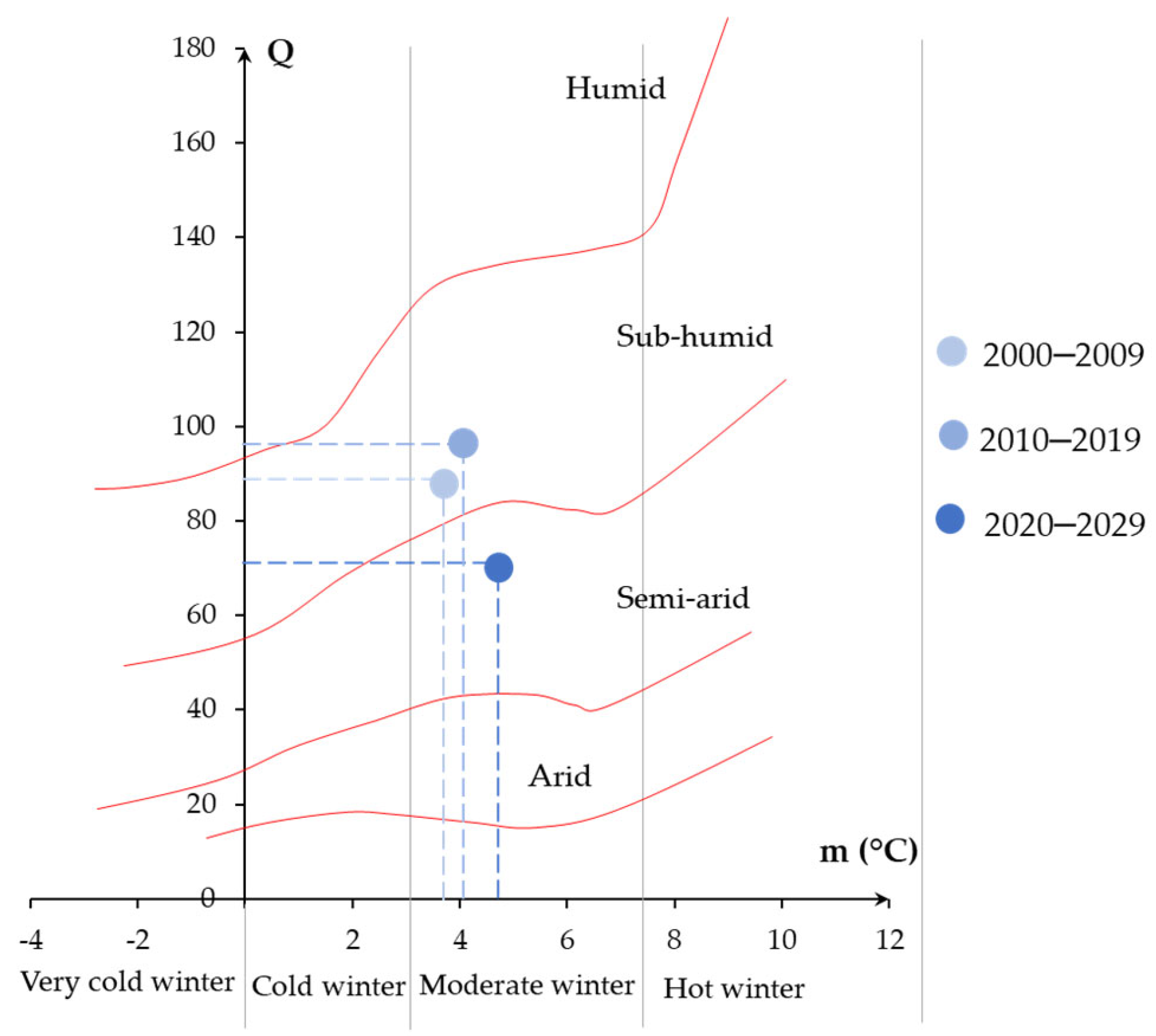

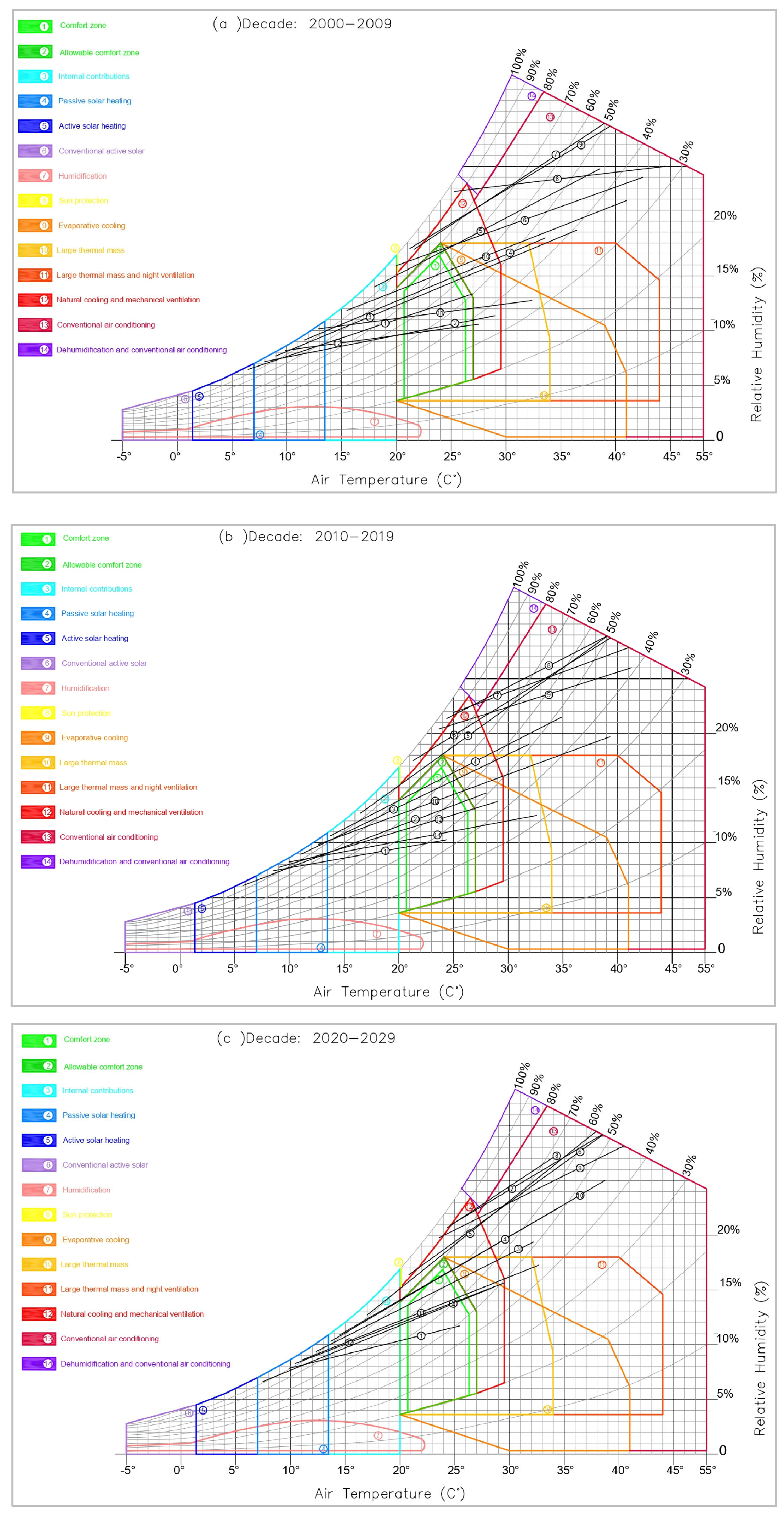

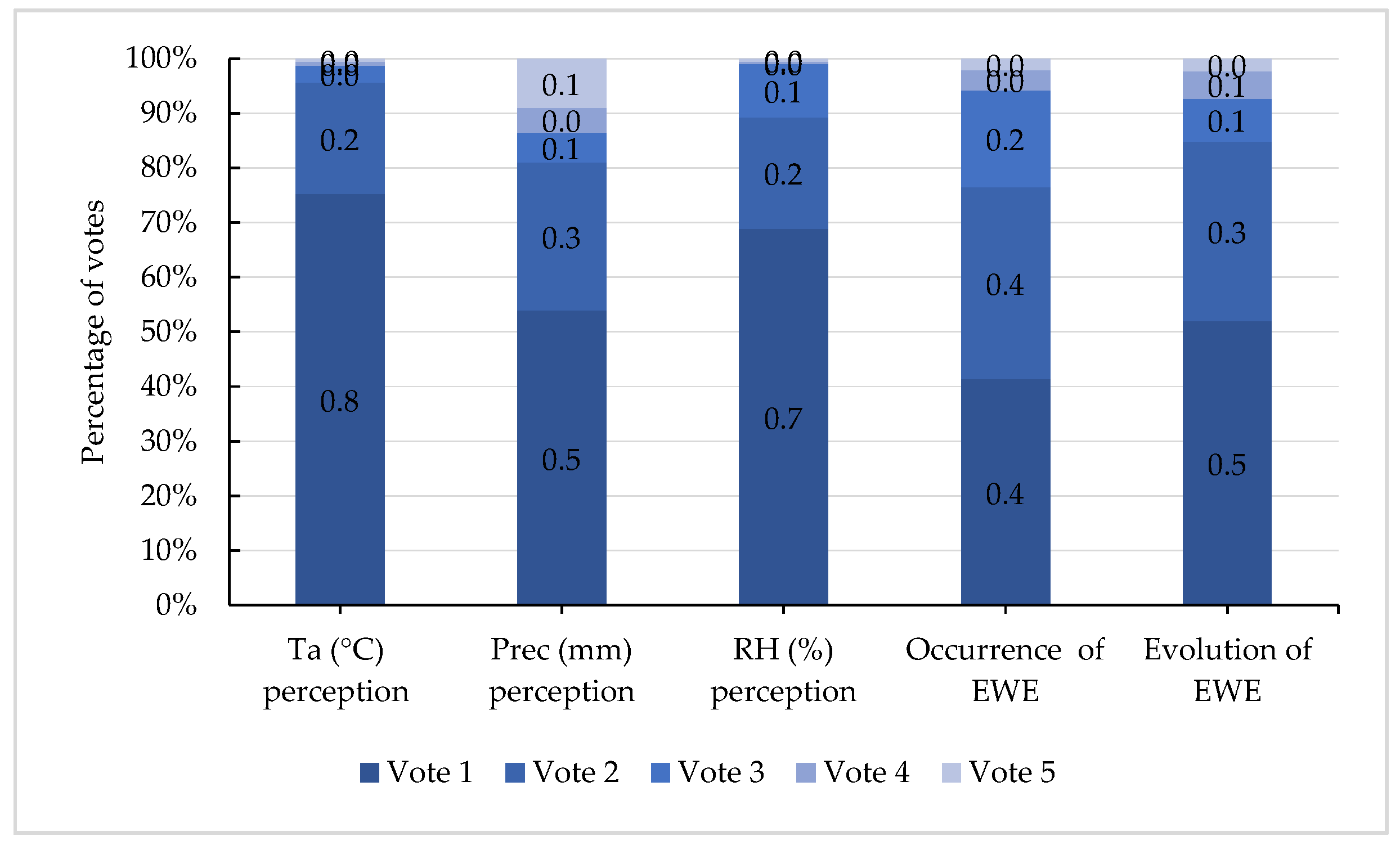



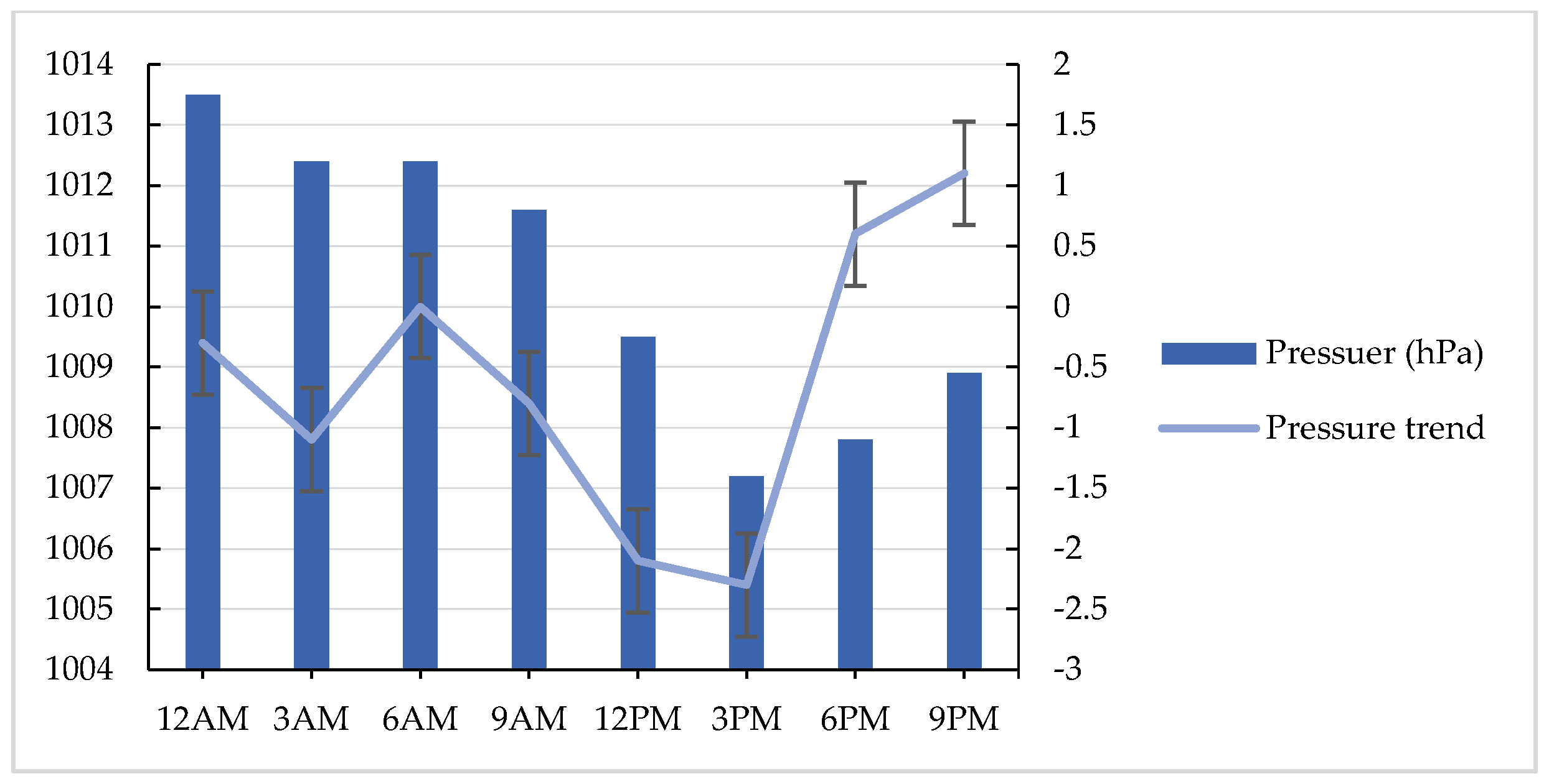
| Categories | Intervals |
|---|---|
| Semi-arid | 15 ≤ I ≤ 24 |
| Moderately arid (Mediterranean) | 24 ≤ I ≤ 30 |
| Slightly arid | 30 ≤ I ≤ 35 |
| Moderately humid | 35 ≤ I ≤ 40 |
| Humid | 40 ≤ I ≤ 50 |
| Very humid | 50 ≤ I ≤ 60 |
| Climatic Variables | Model’s Formula | Coefficients | |||||||||||
|---|---|---|---|---|---|---|---|---|---|---|---|---|---|
| R² | |||||||||||||
| Ta (°C) | Max | 2.3 | 0.9 | 1.1 | 0.92 | ||||||||
| Mean | 00 | 0.97 | |||||||||||
| Min | −0.1 | 0.95 | |||||||||||
| RH (%) | Max | 33.9 | 0.6 | 1.1 | 0.60 | ||||||||
| Mean | 45.6 | 0.4 | 1.2 | 0.36 | |||||||||
| Min | 36.8 | 0.4 | −5.5 | 0.40 | |||||||||
| Prec (mm) | |||||||||||||
| Coefficients | Months | January | February | March | April | May | June | July | August | September | October | November | December |
| 111.3 | 51.8 | 1179.4 | −1.1 | 199.9 | 87.2 | −3.1 | 2.3 | 70.4 | −85.6 | 74.5 | 169.2 | ||
| −0.8 | −0.3 | −13.4 | 1.1 | −5.6 | −5.9 | 4.9 | −0.1 | −1.4 | 1.8 | 0.1 | −1.1 | ||
| R² | 0.43 | 0.51 | 0.05 | 0.37 | 0.01 | 0.85 | 0.77 | 0.99 | 0.91 | 0.01 | 0.96 | 0.91 | |
| Months | January | February | March | April | May | June | July | August | September | October | November | December |
|---|---|---|---|---|---|---|---|---|---|---|---|---|
| −284.5 | 525.4 | −64,313.3 | 932.9 | 15,352.7 | 2924.6 | 81.4 | −0.5 | 109.1 | 3262.8 | 2262.6 | 2346.8 | |
| 36.0 | 31.4 | 53.1 | 31.5 | 40.5 | 36.7 | 10.4 | 16.4 | 26.2 | 25.4 | 47.7 | 59.2 | |
| 15.1 | 24.2 | 325.4 | 19.0 | 104.6 | 12.8 | 7.5 | 2.4 | 8.9 | 38.3 | 9.1 | 14.5 | |
| R2 | 0.43 | 0.51 | 0.05 | 0.37 | 0.01 | 0.85 | 0.77 | 0.99 | 0.91 | 0.01 | 0.96 | 0.91 |
| Date | Temperature | HR | Wind | Pres | Prec | Clo | Vis | Daily Weather Summary | |||
|---|---|---|---|---|---|---|---|---|---|---|---|
| (km/h) | |||||||||||
| Max | Min | Mean | (%) | Dir | Spe | (Hp) | (mm) | Okt | Km | ||
| Week before | 38.2 | 23.7 | 30.7 | 64.5 | N NE | 9.5 | 1014.0 | 0.0 | 0.0 | 10.6 |  |
| 24th July | 48.2 | 25.2 | 36 | 31.5 | S SW | 14.6 | 1010.4 | 0.0 | 0.0 | 9.5 |  |
| Week after | 32.3 | 24.3 | 28.4 | 71.9 | N NE | 13.2 | 1013.7 | 0.0 | 1.4 | 10.0 |  |
 Night clear sky;
Night clear sky;  Daytime clear sky;
Daytime clear sky;  Partially cloudy sky;
Partially cloudy sky;  Smoke.
Smoke.Disclaimer/Publisher’s Note: The statements, opinions and data contained in all publications are solely those of the individual author(s) and contributor(s) and not of MDPI and/or the editor(s). MDPI and/or the editor(s) disclaim responsibility for any injury to people or property resulting from any ideas, methods, instructions or products referred to in the content. |
© 2024 by the authors. Licensee MDPI, Basel, Switzerland. This article is an open access article distributed under the terms and conditions of the Creative Commons Attribution (CC BY) license (https://creativecommons.org/licenses/by/4.0/).
Share and Cite
Sayad, B.; Osra, O.A.; Binyaseen, A.M.; Qattan, W.S. Analyzing Urban Climatic Shifts in Annaba City: Decadal Trends, Seasonal Variability and Extreme Weather Events. Atmosphere 2024, 15, 529. https://doi.org/10.3390/atmos15050529
Sayad B, Osra OA, Binyaseen AM, Qattan WS. Analyzing Urban Climatic Shifts in Annaba City: Decadal Trends, Seasonal Variability and Extreme Weather Events. Atmosphere. 2024; 15(5):529. https://doi.org/10.3390/atmos15050529
Chicago/Turabian StyleSayad, Bouthaina, Oumr Adnan Osra, Adel Mohammad Binyaseen, and Wajdy Sadagh Qattan. 2024. "Analyzing Urban Climatic Shifts in Annaba City: Decadal Trends, Seasonal Variability and Extreme Weather Events" Atmosphere 15, no. 5: 529. https://doi.org/10.3390/atmos15050529







